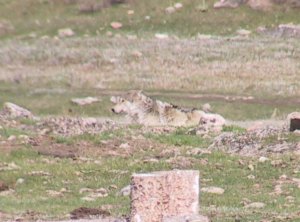Kill order, called “retribution”-
Because there are not many wolves in Oregon, this is a big deal. The pack has 10-14 members. There was one other wolf pack known on the Oregon/Washington state border in 2010 — the Wenaha Pack. It might have 6 members. USFWS has ordered capturing and “euthanizing two un-collared sub-adults from the Imnaha pack.” That wolf pack has killed some cow calves every once and a while over the last year.
Rob Klavins of Oregon Wild said in a statement, “This kill order randomly targets any two wolves of Oregon’s Imnaha Pack. That is not wildlife management, it is retribution.”
My view is that, of course, it is retribution. After watching and writing about wolf depredations of cattle for over 15 years now, I’d say “wolf control” is almost always retribution of a kind. Wolves rarely kill enough livestock in any place to make the dead calf or sheep an economic issue, but it is always a political issue. Wolves killing livestock are treated with the same gravity as human homicides and political assassinations, reflecting the values of those who rule in western rural areas.
Here is the story in Sneak Cat. USFWS issues kill order for 2 Imnaha Pack wolves. May 3, 2011.
Update on Oregon wolf packs (taken from a news story). “Oregon currently has three wolf packs: the Imnaha (10 wolves at latest count), Wenaha (six wolves) and Walla Walla (three wolves). The Walla Walla pack is new and wildlife managers are still trying to determine their range, which could primarily be in Washington State.”











 Benjamin Tuggle, Southwest regional director of U.S. Fish & Wildlife Service (FWS) has published an Op-Ed in the Arizona Republic:
Benjamin Tuggle, Southwest regional director of U.S. Fish & Wildlife Service (FWS) has published an Op-Ed in the Arizona Republic: 

